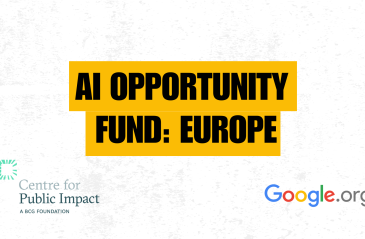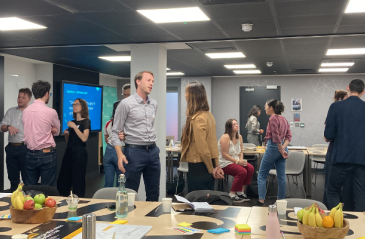
Embracing AI: Empowering vulnerable workers for a more inclusive future

How does @hickforco stay focused in #Colorado? By having a long-term vision which supports and underpins his initiatives
Share articleBecause the role is so visible, #mayors have to be more communicative and more effective in everything they do, says @PeteButtigieg
Share articlePeople don’t trust don’t trust the federal government to do its job, says @matthewjdowd, so #cities and state govts can step into the vacuum
Share articleWe put our vision for government into practice through learning partner projects that align with our values and help reimagine government so that it works for everyone.
Across the US and Canada, cities are proving to be vibrant hubs for dynamic, citizen-centric problem-solving - something that I have witnessed first-hand during the Centre for Public Impact's extensive work supporting Bloomberg Philanthropies' 2018 Mayors Challenge.
So, how can city leaders innovate, meet rising citizen expectations and achieve a positive impact? Some key lessons have emerged, many of which are cited in our conversations listed below.
Take the importance of resident engagement. We've learned that city governments need to take a human-centered approach, proactively seeking resident feedback and co-creating solutions. Forward-looking city governments, including many of the Mayors Challenge Champion Cities, are working with citizens to try new ways of testing and failing well - taking an iterative, build and learn approach that is common in the private sector but rare in government. This kind of innovation not only requires bold leadership from the top, but also new internal capability and proactive channels for collaboration with external partners in the private and social sector.
Through our work with city governments, we've also learned about the value of storytelling and effective communication. City leaders that engage voters and stakeholders alike are cities that develop solutions for which citizens take pride.
Finally, we've learned about some of the pitfalls in innovation. We know that just because a programme works well in one city, that doesn't mean it will in another. Transferability requires context. And although city leaders may instinctively want to make their mark early, it's important that they don't innovate for innovation's sake. Rather than getting caught up with the flash of a cool app or new technology, it's much more important to consider how each tool fits with solutions that are grounded in a clear understanding of the problems they are seeking to solve.
As more and more people flock to city borders to live and work, it is clear that this will be an ongoing conversation - one that the Centre for Public Impact will be continuing to help drive in the months and years to come.
Here, we present 12 Top Tips on driving impact and innovation in North American cities.
1. Talk with your communities
John Hickenlooper, Governor of Colorado
“We incorporated our community engagement results together and used them to make a regional and state plan. It was amazingly insightful and it was consistent across the state about what our priorities should be. It also brought people together from across the state to get to know each other."
2. Communicate and be clear about your priorities
Pete Buttigieg, Mayor of South Bend
"I'm lucky if I get to spend about 20% of my time on actual policy work. My job is mainly to do with selling it and making sure it is communicated well.”
3. Tell a story with your data
Beth Blauer, Executive Director, Johns Hopkins University Center for Government Excellence
"When we talk to leaders today about data and evidence and analytics - we have to do a better job at selling why it's so important, rather than having their eyes glaze over. We should do this by telling the story of the people this will have an impact on - both citizens and government employees."
4. Build a groundswell of support
Gregor Robertson, Mayor of Vancouver
"A leader needs broad support for major change to occur - we can lead the charge in government but engagement is crucial. Some 35,000 residents were involved in shaping the Greenest City 2020 plan, and this has led to many different neighbourhoods and community groups having a direct stake in what we are doing. Ultimately, it's all about people power.”
5. Explain - clearly - the purpose behind unpopular decisions
Martin O'Malley, former Mayor of Baltimore and Governor of Maryland
"When I was governor we had to do a lot of tough and unpopular things early on. But when it came to re-election we were able to make a pretty compelling argument that we were outperforming Virginia and Pennsylvania. This was communicated, and we won by twice the margin at re-election in what was a tough year for Democrats. Leaders have to do a better job of telling these stories in a shorter period of time in order for the public to distinguish between the things that work and the things that are just noise.”
6. Have a clear vision, and take people with you
Annise Parker, former Mayor of Houston
"You really need to know where you're going in order to get there. You can have the best idea in the world but if you can't effectively articulate that idea you can't go anywhere with it. If you can't convince other people of the worth of that idea and the need for them to engage with you, you're just not going to make progress."
7. Seek out the stakeholders
Sly James, Mayor of Kansas City, Missouri
"It's dangerous for a person to put out an idea and stand on it alone because then you're inviting others to criticise it and then it doesn't happen. But when you bring those who are going to be affected together, then you've got much greater chance of success and sustainability over the long haul."
8. Find out what works and be willing to test and adapt accordingly
Michele Jolin, CEO and co-Founder, Results for America
"Whenever a policymaker or decision-maker has to make a choice, he or she should look to the evidence and data about what works, as well as continually consider whether the funding is making a difference as intended. We know that there will be other factors - politics will always play a role, we're not naïve about that - but we want to make evidence matter more."
9. Listen to what voters want, and then take action
Mick Cornett, Mayor of Oklahoma City
"We held a referendum on putting new, pedestrian-friendly elements into our infrastructure, and voters approved a one cent sales tax, set to expire after seven years, with a target of raising $777 million. Now we're building hundreds of miles of sidewalks, new jogging and biking trails throughout the city, landscaping and narrowing streets to make them a more interesting walk. We're creating a city that is designed around people, rather than being designed around the car.”
10. Leave partisanship at the door and seek consensus where possible
Kevin Faulconer, Mayor of San Diego
"People will disagree - that's inevitable - but I have found that when you communicate and try to build consensus, the opportunities for success are far more visible than when you try and ram something through. Usually those policies don't stand the test of time.”
11. Take advantage of the proximity of the people
Matthew Dowd, Chief Political Analyst, ABC News and Founder, Listen To Us
"When you're in a local situation you have greater direct interaction with the people who are affected by your policy. And so you hear from them and you see them on a daily basis. You're actually in their neighbourhoods and this reflects the fact in most cities around the country you achieve power by consensus, rather than party.”
12. Innovate for impact and around a specific need
Leigh Tami, Chief Performance Officer, Cincinnati
"Our approach is twofold: first, to see if we can integrate it with our existing infrastructure; and second, making sure that it actually solves a problem. A lot of this smart city technology stuff looks cool - and is cool - but doesn't necessarily answer a specific need."












